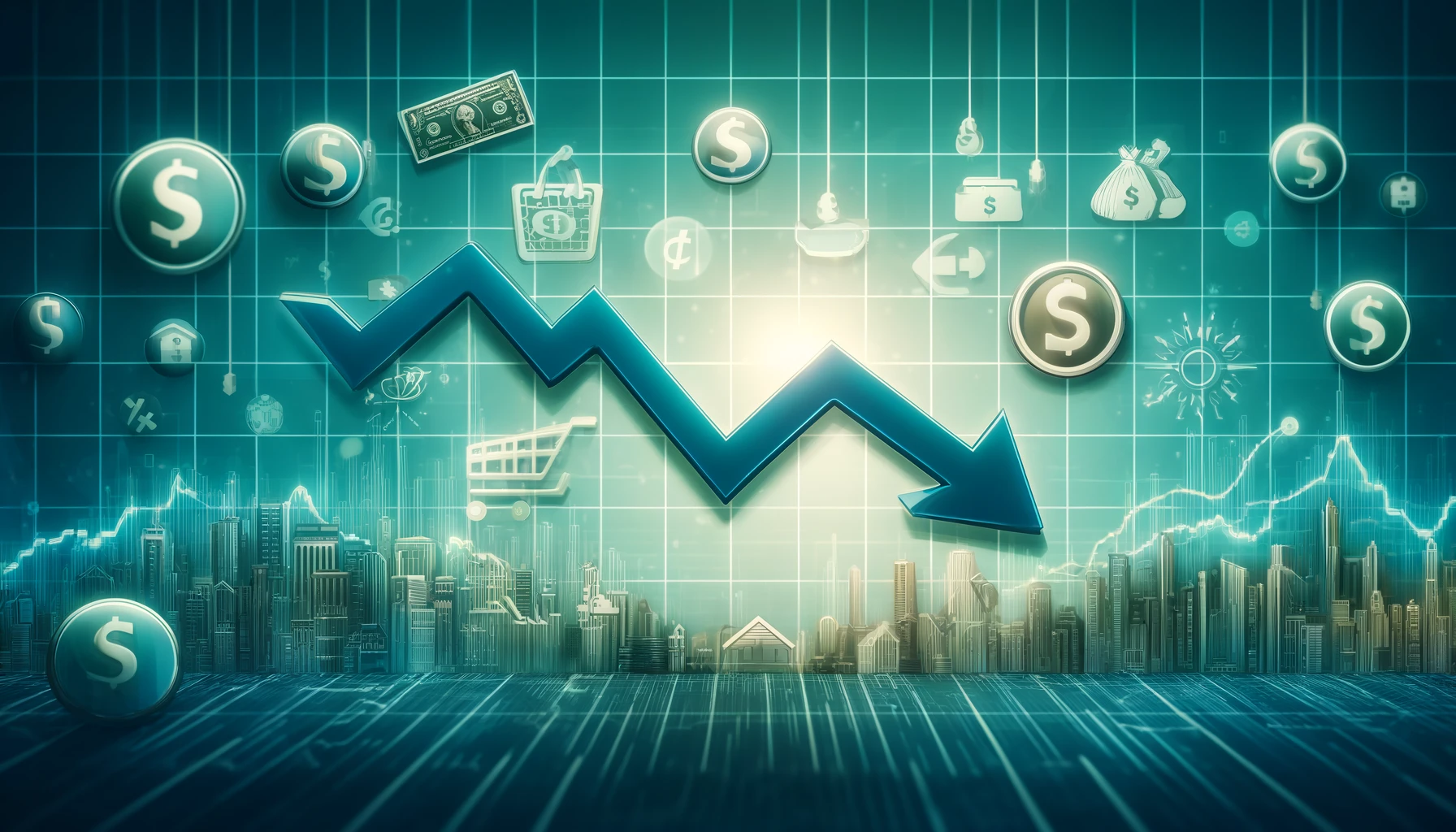Inflation in the United States has shown signs of cooling, offering potential relief for consumers and sparking optimism for possible interest rate cuts. This development could influence economic policies and impact the upcoming presidential election.
Inflation Trends and Economic Impact
In May, consumer prices excluding volatile food and energy costs rose by only 0.2% from the previous month, marking the smallest increase since October. Compared to a year earlier, core prices climbed by 3.4%, down from the previous month’s 3.6% rise. Overall inflation, which includes all items, was unchanged from April to May. Measured from a year earlier, prices rose 3.3%, less than the 3.6% increase recorded in the previous month. These figures suggest that the rapid price increases seen earlier in the year may have peaked.
This slowdown in inflation, if sustained, could prompt the Federal Reserve to consider lowering its benchmark interest rate, which currently stands at a 23-year high. Fed officials are scrutinizing each month’s inflation data to assess their progress in fighting rising prices. The central bank’s key rate influences borrowing costs for mortgages, auto loans, credit cards, and other forms of consumer and business borrowing.
Political Implications
President Biden and his aides had initially abandoned hopes for multiple interest rate cuts before the November election. However, the latest Consumer Price Index report, showing unexpected progress in taming inflation, has revived their optimism. “Prices are still too high, but today’s report shows welcome progress on lowering inflation,” President Biden stated. The Biden campaign further emphasized that wages are rising, and inflation is being controlled, contributing to a strong economy.
Despite these positive indicators, some essentials like groceries, rent, and healthcare remain more expensive than they were three years ago. This ongoing price pressure continues to be a source of public dissatisfaction and a potential threat to President Biden’s re-election bid.
Market Reactions and Expert Opinions
The latest inflation data has set off a new round of calls from President Biden’s allies for the Fed to commence cutting rates. “Today’s release was welcome news that inflation is cooling, and data last week showed a stable and strong job market. Now it’s time to make sure the benefit of that is reaching American families,” said Senator Martin Heinrich, chair of the Joint Economic Committee. He added, “But unnecessarily high rates are holding back small business growth, hurting workers, and worsening the housing crisis. It is time for the Fed to lower interest rates before it causes irreparable harm to the U.S. economy.”


Few investors or economists expect Fed officials to cut interest rates immediately. However, markets are now more confident that a rate cut could come in September if inflation continues to moderate. “We think this starts the clock on a potential September rate cut, but the Fed will need to see much more sustained progress in the months ahead to deliver that cut,” said Krishna Guha, an analyst at Evercore ISI.
Challenges and Considerations
The Federal Reserve, which is closely monitoring inflation trends, has yet to signal any immediate plans to cut interest rates. Fed officials have shown no sign of being swayed by political pressures, and President Biden has resisted calls from some progressives to urge the Fed to cut rates, citing the importance of the central bank’s independence.
Persistently elevated inflation has posed a vexing challenge for the Fed. The longer the Fed keeps borrowing costs high, the more it risks weakening the economy too much and causing a recession. Yet if it cuts rates too soon, it risks reigniting inflation. Chair Jerome Powell stated in early May that the central bank needed more confidence that inflation was returning to its 2% target before reducing its benchmark rate. Fed officials have indicated they need to see several consecutive months of lower inflation to gain that confidence.
Consumer Impact and Future Outlook
The recent inflation report indicated that consumers are beginning to get some relief from the price spikes of the past three years. Grocery costs were unchanged from April to May, after falling 0.2% the previous month. Food prices have risen just 1% over the past 12 months, though they are still up about 20% from three years ago. Average gas prices tumbled 3.6% nationally from April to May, though they remain 2.2% higher than a year earlier. These declines have continued, with gas averaging $3.45 per gallon as of the latest report.
Other signs suggest that inflation will continue to cool in the coming months. Americans, particularly lower-income households, are pulling back on their spending. Several major retail and restaurant chains, including Walmart, Target, Walgreen’s, McDonald’s, and Burger King, have responded by announcing price cuts or deals.
Tom Porcelli, chief U.S. economist at PGIM Fixed Income, commented, “It’s certainly welcome news. It drives home that the inflation challenge in the United States is not as challenging as monetary policy makers believe.”
This article is based on the following articles:

Background Information
What is Inflation?
Inflation is the rate at which the general level of prices for goods and services rises, leading to a decrease in the purchasing power of money. When inflation is high, each unit of currency buys fewer goods and services. Inflation is typically measured by the Consumer Price Index (CPI) and the Producer Price Index (PPI).
- Consumer Price Index (CPI): This measures the average change over time in the prices paid by urban consumers for a market basket of consumer goods and services. It includes costs for items such as food, clothing, shelter, and medical care.
- Core CPI: This version of the CPI excludes volatile food and energy prices, providing a clearer picture of underlying inflation trends.
Why Does Inflation Happen?
Inflation can occur for several reasons, including:
- Demand-Pull Inflation: When demand for goods and services exceeds their supply, prices rise.
- Cost-Push Inflation: When the costs of production increase (for example, due to higher prices for raw materials), these costs are often passed on to consumers in the form of higher prices.
- Built-In Inflation: When workers demand higher wages to keep up with rising costs of living, businesses may increase prices to cover the higher wage costs, creating a cycle of rising prices and wages.
Effects of Inflation
High inflation can erode purchasing power, making it harder for people to afford the same amount of goods and services. It can also impact savings, as the value of money saved decreases over time if it does not earn a return that keeps up with inflation. On the other hand, moderate inflation can be a sign of a growing economy, as it can encourage spending and investment.
What are Interest Rates?
Interest rates are the cost of borrowing money, typically expressed as an annual percentage of the loan amount. The Federal Reserve, often referred to as the Fed, influences interest rates in the U.S. economy.
Federal Reserve and Monetary Policy
The Federal Reserve is the central bank of the United States. It uses monetary policy to manage economic growth and stability. The Fed’s main tool is the federal funds rate, the interest rate at which banks lend to each other overnight. Changes in the federal funds rate influence other interest rates, such as those for mortgages, auto loans, and business loans.
Monetary Policy Tools
- Open Market Operations: Buying and selling government securities to influence the supply of money.
- Discount Rate: The interest rate charged to commercial banks and other financial institutions for short-term loans from the Federal Reserve.
- Reserve Requirements: Regulations on the minimum amount of reserves that banks must hold against deposits.
Why Does the Fed Change Interest Rates?
The Fed changes interest rates to either stimulate the economy or to cool it down.
- To Combat Inflation: If inflation is high, the Fed may increase interest rates to make borrowing more expensive, which can reduce spending and slow down the economy.
- To Stimulate Growth: If the economy is slow and unemployment is high, the Fed may lower interest rates to make borrowing cheaper, encouraging spending and investment.
Recent Economic Context
In recent years, the U.S. has experienced significant economic turbulence due to factors such as the COVID-19 pandemic, supply chain disruptions, and changes in consumer behavior. The pandemic led to a sudden economic downturn, prompting the Fed to lower interest rates to nearly zero to support economic activity. As the economy recovered, demand surged, but supply chain issues caused shortages, leading to higher prices and inflation.
Inflation and the Federal Reserve’s Response
As inflation started to rise, the Fed began increasing interest rates in 2022 and 2023 to try to control it. These rate hikes made borrowing more expensive, which was intended to reduce spending and slow inflation. However, high interest rates also increased the cost of mortgages, auto loans, and credit cards, which could potentially slow economic growth too much, leading to a recession.
Political and Social Implications
Inflation and interest rates are not just economic issues; they also have significant political and social implications. Rising prices for essentials like food, housing, and healthcare can lead to public dissatisfaction, affecting political support for elected officials. The balance between controlling inflation and supporting economic growth is a delicate one that can influence voter behavior and election outcomes.
Current Situation
As of mid-2024, inflation in the U.S. has shown signs of easing, with recent data indicating a slowdown in price increases. This has sparked optimism for potential interest rate cuts, which could lower borrowing costs and support economic activity. However, the Federal Reserve remains cautious, needing to see sustained progress before making significant policy changes.

Debate/Essay Questions
- What are the political implications of inflation on the upcoming presidential election?
Please subscribe to Insight Fortnight, our biweekly newsletter!
